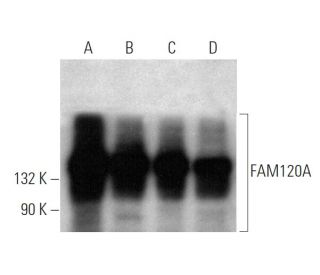

Anticorps FAM120A (1501CT803.19.85.5): sc-517328
- L'anticorps FAM120A 1501CT803.19.85.5 est un monoclonal IgG1 (chaîne légère kappa) L'Anticorps FAM120A fourni en 100 µg/ml
- élevé contre une protéine recombinante correspondant à FAM120A d'origine human
- recommandé pour la détection de FAM120A d'origine human par WB, IP, IF et IHC(P)
- Nous testons actuellement encore nos anticorps secondaires pour trouver la meilleure protéine de liaison pour cet anticorps primaire FAM120A (1501CT803.19.85.5). Veuillez nous contacter si vous avez des questions concernant les réactifs de détection secondaire appropriés.
L'anticorps FAM120A (1501CT803.19.85.5) est un anticorps monoclonal de chaîne légère kappa IgG1 de souris qui détecte la protéine FAM120A d'origine humaine par western blotting (WB), immunoprécipitation (IP), immunofluorescence (IF) et immunohistochimie sur coupes incluses en paraffine (IHCP). L'anticorps anti-FAM120A (1501CT803.19.85.5) est disponible sous forme non conjuguée. FAM120A, également connue sous le nom d'OSSA (Oxidative stress-associated Src activator) ou de C9orf10, est un suppresseur de tumeur de 1 118 acides aminés qui joue un rôle essentiel dans les voies de signalisation cellulaires, en particulier en réponse au stress oxydatif. FAM120A est principalement localisé dans le cytoplasme et la membrane cellulaire, ce qui est important car cette localisation est essentielle pour activer les kinases de la famille Src, influençant ainsi la survie et la prolifération des cellules dans des conditions de stress. FAM120A est exprimée de manière ubiquitaire, avec des niveaux particulièrement élevés dans les tissus gastriques cancéreux de type scirrhoïde par rapport à la muqueuse gastrique normale, ce qui met en évidence son rôle potentiel dans la biologie du cancer. En tant que membre de la famille des coactivateurs constitutifs de PPAR-gamma, FAM120A ne se contente pas de lier l'ARN, mais favorise également la sécrétion du facteur de croissance analogue à l'insuline II (IGF-II) et existe sous la forme de cinq isoformes épissées alternativement, ce qui peut contribuer à la diversité de ses rôles fonctionnels. Le gène codant pour FAM120A est situé sur le chromosome 9 humain, qui comprend environ 145 millions de bases et représente environ 4 % du génome humain, codant pour près de 900 gènes, ce qui souligne la complexité et l'importance de cette protéine dans divers processus biologiques.
Alexa Fluor® est une marque déposée de Molecular Probes Inc., OR., USA
LI-COR® et Odyssey® sont marques déposées de LI-COR Biosciences
FAM120A Références:
- Le gène humain CXorf17 code pour un membre d'une nouvelle famille de protéines transmembranaires putatives: clonage de l'ADNc et caractérisation de CXorf17 et de son orthologue murin orf34. | Holden, S. and Raymond, FL. 2003. Gene. 318: 149-61. PMID: 14585507
- Un atlas quantitatif de la phosphorylation mitotique. | Dephoure, N., et al. 2008. Proc Natl Acad Sci U S A. 105: 10762-7. PMID: 18669648
- Une nouvelle protéine de liaison à l'ARN, Ossa/C9orf10, régule l'activité des kinases Src pour protéger les cellules de l'apoptose induite par le stress oxydatif. | Tanaka, M., et al. 2009. Mol Cell Biol. 29: 402-13. PMID: 19015244
- L'analyse phosphoprotéomique quantitative de la signalisation des récepteurs des cellules T révèle une modulation des interactions protéine-protéine à l'échelle du système. | Mayya, V., et al. 2009. Sci Signal. 2: ra46. PMID: 19690332
- Caractérisation initiale du protéome central humain. | Burkard, TR., et al. 2011. BMC Syst Biol. 5: 17. PMID: 21269460
- Une approche RP-RPLC assistée par enzyme pour une analyse approfondie du phosphoprotéome du foie humain. | Bian, Y., et al. 2014. J Proteomics. 96: 253-62. PMID: 24275569
- Prédiction des séquences codantes de gènes humains non identifiés. V. Séquences codantes de 40 nouveaux gènes (KIAA0161-KIAA0200) déduites de l'analyse de clones d'ADNc provenant de la lignée cellulaire humaine KG-1. | Nagase, T., et al. 1996. DNA Res. 3: 17-24. PMID: 8724849
Informations pour la commande
| Nom du produit | Ref. Catalogue | COND. | Prix HT | QTÉ | Favoris | |
Anticorps FAM120A (1501CT803.19.85.5) | sc-517328 | 100 µg/ml | $316.00 |
